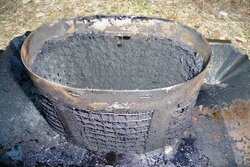Ah yes. See below. Install was last October, started with great wood, good draft. Last few weeks the draft has been terrible, and the wood has been suspect (but not hissing wet). I didn't have all I needed to get up on the roof - I have to clean top down but my ladder isn't tall enough. Today I finally rigged a stainless steel line across the ridge as a safety line...
The pipe isn't actually too bad - maybe an 1/8th to a 1/4 " of creosote at the top, and dry, not sticky.
Even still, I feel a little embarrassed I didn't get up there sooner....
PS. This is the cap off the roof, and upside down..
The pipe isn't actually too bad - maybe an 1/8th to a 1/4 " of creosote at the top, and dry, not sticky.
Even still, I feel a little embarrassed I didn't get up there sooner....
PS. This is the cap off the roof, and upside down..


